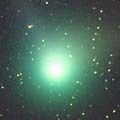
|
It was fantastic, so bright as 3.5 mag, so large as 30 arcmin, locating high overhead at its best time in early January. Then it has been getting fainter and smaller gradually, and 6.6 mag now (Mar. 21, Reinder J. Bouma). Although it became too faint to see with naked eyes, it is still easy to see with binoculars because moderately condensed as DC=5. It looks rather small with a diameter of about 10 arcmin. It is visible all night in the Northern Hemisphere. In the Northern Hemisphere, it keeps observable in good condition for a long time while the comet is bright enough visible visually until October when it becomes faint as 14 mag. It will be bright at 8.5 mag, so people can enjoy it with binoculars still in May.
Date(TT) R.A. (2000) Decl. Delta r Elong. m1 Best Time(A, h)
Mar. 26 10 47.02 80 4.8 1.028 1.517 96 6.9 22:34 (180,-25)
Apr. 2 11 18.90 76 38.4 1.100 1.581 97 7.2 22:37 (180,-21)
|
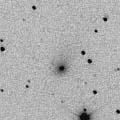
|
The brightening evolution had been slower than a typical comet since its discovery until February. However, it suddenly became bright and large in March. It was small as 10.3 mag and 1.9 arcmin on Feb. 5, but transfigured dramatically within one month as 7.8 mag and 6 arcmin on Mar. 8 (Seiichi Yoshida). It kept constant brightness visually after that, and 7.8 mag on Mar. 21 (Kamil Hornoch). On the other hand, it brightened rapidly within one month by CCD observations, from 9.4 mag on Mar. 1 to 8.0 mag on Mar. 25 (Ken-ichi Kadota). In the Northern Hemisphere, it will be unobservable in early April. In the Southern Hemisphere, it keeps observable forever after this. It keeps bright as around 8 mag until May. Reinder J. Bouma pointed out that the slow brightening is similar to C/1999 S4 or C/2002 O7. The current rapid brightening may be a sign of something? Unusually strong non-gravitational parameters are revealed by the orbital calculation.
Date(TT) R.A. (2000) Decl. Delta r Elong. m1 Best Time(A, h)
Mar. 26 21 34.47 -4 54.9 1.295 0.865 41 7.6 4:43 (262, 20)
Apr. 2 22 0.96 -11 10.6 1.213 0.850 43 7.4 4:49 (266, 25)
|
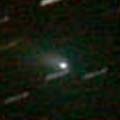
|
Brightening rapidly. In January when it was visible in the Northern Hemisphere, it was an 11 mag small object. However, after it has gone to the southern sky, a very large appearance, 9.2 mag and 8 arcmin, was observed on Feb. 14 (David Seargent). The size became a bit smaller after that, about 4-5 arcmin, however, now it is so bright as 8.0 mag, bright enough to be visible with binoculars (Mar. 15, Alexandre Amorim). It becomes very low even in the Southern Hemisphere until mid May. Then it will be higher again, and keeps observable while fading gradually. In the Northern Hemisphere, it is not observable until June when it appears in the morning at 12.5 mag.
Date(TT) R.A. (2000) Decl. Delta r Elong. m1 Best Time(A, h)
Mar. 26 1 23.31 -50 58.3 1.058 0.947 54 8.0 19:27 ( 44, 24)
Apr. 2 1 33.72 -43 19.2 1.168 0.919 49 8.1 19:17 ( 50, 19)
|

|
It was bright as 7.5 mag in early January, easy to see with binoculars. However, it has been fading and getting diffused rapidly in the evening sky since that. It became 9 mag in early Feburary, and reached to 10.7 mag now (Mar. 15, Alexandre Amorim). Although it became faint very quickly, the fading pace was slower than usual. It is already very low in the evening sky, very faint and diffused, so hard to see. It will be unobservable soon. But it will appear in the morning sky again in August. It may be still brighter than 14 mag at that time and visible visually.
Date(TT) R.A. (2000) Decl. Delta r Elong. m1 Best Time(A, h)
Mar. 26 3 37.35 -12 23.9 3.148 2.640 51 11.1 19:27 ( 96, 30)
Apr. 2 3 40.40 -10 57.5 3.313 2.722 46 11.3 19:17 ( 95, 27)
|
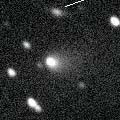
|
It was not visible visually still in February, fainter than 13.9 mag (Feb. 5, Seiichi Yoshida), however, it finally began to be visible visually at 13.3 mag in March (Mar. 1, Juan Jose Gonzalez). It is brightening rapidly, but fainter than expected by 0.5 mag, 12.4 mag now (Mar. 18, Juan Jose Gonzalez). It is small, but rather well condensed, so easy to see. It is fainter than this ephemeris by about 1 mag by CCD. It will reach to 10 mag in spring and summer. It may become a naked-eye object due to the Deep Impact mission on July 4.
Date(TT) R.A. (2000) Decl. Delta r Elong. m1 Best Time(A, h)
Mar. 26 13 25.15 12 32.4 0.837 1.801 158 12.0 1:12 (180, 43)
Apr. 2 13 20.67 12 58.1 0.794 1.767 160 11.7 0:40 (180, 42)
|
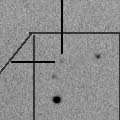
|
The condition of this return is bad. It is not observable around the perihelion passage. It will appear at dawn in July at 14.5 mag, then it will be fading after that.
Date(TT) R.A. (2000) Decl. Delta r Elong. m1 Best Time(A, h)
Mar. 26 23 31.84 -8 27.5 2.418 1.484 15 12.2 4:43 (282, -2)
Apr. 2 23 52.64 -6 44.0 2.428 1.505 17 12.3 4:49 (279, -1)
|
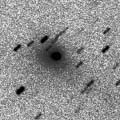
|
It has been small at 12.5-13.0 mag since November. It keeps observable with the same appearance and brightness in the evening sky until May.
Date(TT) R.A. (2000) Decl. Delta r Elong. m1 Best Time(A, h)
Mar. 26 4 38.45 30 17.8 1.974 1.834 67 12.7 19:27 (141, 12)
Apr. 2 4 56.95 31 5.1 2.028 1.833 64 12.8 19:17 (141, 11)
|

|
It will reach to 10 mag in June and July. It keeps locating rather low in the morning until that. It was 14.8 mag on Mar. 17 (Ken-ichi Kadota), brightening almost as expected. It tends to be brighter before the perihelion passage. It will become visible visually at 13 mag in April.
Date(TT) R.A. (2000) Decl. Delta r Elong. m1 Best Time(A, h)
Mar. 26 20 42.36 8 16.7 2.031 1.662 54 13.2 4:43 (242, 22)
Apr. 2 21 3.38 10 5.6 1.943 1.599 55 12.8 4:49 (239, 23)
|
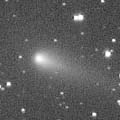
|
Although it had been strongly condensed until early January, it became diffused since late January. It is fading gradually, around 11.5 mag in January and around 12.5 mag in February. It was still bright at 12.6 mag on Mar. 8 (Seiichi Yoshida). Although the brightening evolution before the perihelion passage was extremely rapid, the fading after the perihelion passage is slow as expected. It will be visible visually until May when it becomes too low in the evening sky at 13-14 mag.
Date(TT) R.A. (2000) Decl. Delta r Elong. m1 Best Time(A, h)
Mar. 26 5 1.62 17 11.5 2.470 2.339 70 12.9 19:27 (137, 25)
Apr. 2 5 14.20 17 33.1 2.573 2.367 66 13.0 19:17 (136, 24)
|
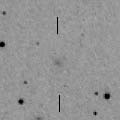
|
Michael Jager succeeded to observe the component A in the extremely low sky at dusk on Feb. 27. It was 12.0 mag, a bit brighter than this ephemeris. Note that the actual position is somewhat off from the prediction. The component D has not been detected yet. It has already passed 2 weeks after the perihelion passage, however, it still keeps bright as 11.5-12.0 mag (Mar. 13, Michael Jager). In its previous return, the component A became brightest about 10 days after the perihelion passage. The recent brightness seems to coincide with the trend well. The The condition of this appearance is bad. In the Northern Hemisphere, it becomes highest in April, but only 19 deg high. It locates lower in the Southern Hemisphere. It will fade out very rapidly after this. It will be fainter than 16 mag at the end of April, too faint to detect on the images.
Date(TT) R.A. (2000) Decl. Delta r Elong. m1 Best Time(A, h)
Mar. 26 2 34.42 12 59.0 1.470 0.869 35 12.9 19:27 (108, 3)
Apr. 2 3 13.90 14 25.5 1.490 0.931 37 13.4 19:17 (113, 7)
|
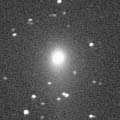
|
Although it had been rather large and easy to see until February, it became small as 1 arcmin, and the condensation became weak in early March. But it is still visible at 12.5 mag. In the Northern Hemisphere, it keeps the same altitude at 35 deg high in the evening sky until June when it fades down to 15 mag.
Date(TT) R.A. (2000) Decl. Delta r Elong. m1 Best Time(A, h)
Mar. 26 2 10.28 65 39.6 2.634 2.417 66 13.1 19:27 (152,-29)
Apr. 2 2 39.72 67 14.1 2.702 2.460 65 13.2 19:17 (155,-28)
|
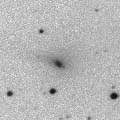
|
It brightened rapidly in January and reached to 13 mag. It is 12.8 mag, small as 0.9 arcmin, and unexpectedly rather well condensed (Mar. 8, Seiichi Yoshida). It will keep bright at 13 mag in the evening sky until April.
Date(TT) R.A. (2000) Decl. Delta r Elong. m1 Best Time(A, h)
Mar. 26 4 51.56 20 24.0 1.423 1.409 68 13.3 19:27 (137, 21)
Apr. 2 5 15.96 22 32.7 1.474 1.430 67 13.4 19:17 (140, 21)
|

|
It was 18.5 mag still in mid January. The brightening is slower than expected. The ephemeris says it will brighten rapidly after this, and reach to 8 mag from July to August. However, it is not observable for a while. In the Northern Hemisphere, it will appear at dawn at 11.5 mag in late May, then it keeps observable for a long time after that. In the Southern Hemisphere, it only appears in the morning very low sky from late April to mid June, but not observable when the comet is bright.
Date(TT) R.A. (2000) Decl. Delta r Elong. m1 Best Time(A, h)
Mar. 26 0 32.79 -8 43.3 2.695 1.728 11 14.0 19:27 ( 73, -9)
Apr. 2 0 37.65 -5 34.0 2.641 1.669 10 13.7 4:49 (284,-10)
|

|
Not observable. It will appear at dawn again in June. It had been always brighter than 13 mag and visible visually all through the season in 2004. In 2005, it is observable in very good condition, almost overhead in the Northern Hemisphere from summer to winter. It can be a good target of observaions if it becomes active as in 2004.
Date(TT) R.A. (2000) Decl. Delta r Elong. m1 Best Time(A, h)
Mar. 26 0 55.22 13 58.9 6.696 5.737 14 13.8 19:27 ( 95,-18)
Apr. 2 1 0.72 14 32.8 6.718 5.737 10 13.8 19:17 ( 94,-20)
|
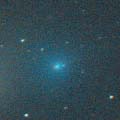
|
It has been large and extremely diffused visually. It was bright and large in early January, 11 mag and 2-5 arcmin, however, it became much fainter and smaller in early February, 12.5 mag and 1.5 arcmin. It became fainter and smaller further more on Mar. 8, 13.3 mag and 0.8 arcmin (Seiichi Yoshida).
Date(TT) R.A. (2000) Decl. Delta r Elong. m1 Best Time(A, h)
Mar. 26 12 33.08 20 32.4 0.901 1.860 157 13.9 0:20 (180, 34)
Apr. 2 12 27.73 20 23.2 0.950 1.901 154 14.3 23:43 (180, 35)
|

|
It was expected to reach to 13.5 mag at opposition in March and April. But actually, it is much fainter than expected, 15.0 mag on Mar. 19 by CCD observations. However, it is the magnitude attached to the astrometry, so the true brightness may be brighter than reported. Due to the retrograde orbit, it moves very fast from the morning sky to the evening sky, and immediately becomes unobservable. In the Northern Hemisphere, it locates very low in the south, so it may be impossible to see it visually.
Date(TT) R.A. (2000) Decl. Delta r Elong. m1 Best Time(A, h)
Mar. 26 11 24.72 -33 23.6 1.143 2.048 146 14.0 23:04 (180, 88)
Apr. 2 10 35.62 -28 9.9 1.169 2.048 141 14.0 21:48 (180, 83)
|
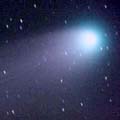
|
It kept bright as 12-13 mag visually since last November until February. It was diffused as DC=2, but bright as 12.0 mag with a diameter of 0.9 arcmin on Feb. 5 (Seiichi Yoshida). However, it had been fading on and on by CCD observations. It became so faint as 15.9 mag in late February by CCD (Feb. 27, Akimasa Nakamura), and the difference between visual and CCD observations became extremely large. However, no visual observations have been reported since Feb. 13, so it is uncertain if the comet is still visible visually or not. It keeps observable for a long time after this in the Northern Hemisphere, however, now it is low both in the evening and morning sky. It will be unobservable in the evening soon. The altitude in the morning sky keeps low around 20 deg for a while after this.
Date(TT) R.A. (2000) Decl. Delta r Elong. m1 Best Time(A, h)
Mar. 26 0 25.00 54 11.2 4.868 4.327 52 14.4 19:27 (135,-39)
Apr. 2 0 35.10 54 16.8 4.982 4.399 49 14.5 4:49 (224,-37)
|

|
It will reach to 9 mag in 2006 spring. In the Southern Hemisphere, it keeps observable until that. In the Northern Hemisphere, it will be too low in the evening soon. Then it keeps unobservable until 2006 March, except it appears very low in the morning at 12 mag from late August to early September. After 2006 March, northern people can observe it for a long time while it is getting fainter. It has been brightening well as expected until early 2005.
Date(TT) R.A. (2000) Decl. Delta r Elong. m1 Best Time(A, h)
Mar. 26 4 8.84 -15 38.6 4.546 4.128 59 14.9 19:27 ( 98, 39)
Apr. 2 4 10.31 -15 18.7 4.558 4.062 54 14.9 19:17 ( 96, 35)
|
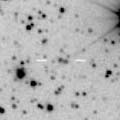
|
It brightened from 18 to 15 mag during one year from the end of 2003 to early 2005. The brightness evolution was much faster than that of a typical comet. It will become too low in the evening at 15 mag in June. Then it can be 13 mag and may be visible visually in next winter. However, after it reached to 15.2 mag in December and January at opposition, it is getting a bit fainter and 15.5 mag still in March, although it should have brighten slowly by calculation.
Date(TT) R.A. (2000) Decl. Delta r Elong. m1 Best Time(A, h)
Mar. 26 5 32.74 47 0.5 6.003 5.920 80 15.1 19:27 (159, 3)
Apr. 2 5 37.28 46 51.4 6.076 5.895 74 15.1 19:17 (156, 2)
|
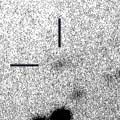
|
It has been brightening rapidly as expected, 19 mag in January and 17 mag in February. It keeps visible as bright as 12-13 mag for a long time from May to September. The condition is good in the Southern Hemisphere, but it locates very low in the Northern Hemisphere. In the previous return, it was 1.5 mag brighter than this ephemeris visually. So it can be around 11.0 mag visually at best in this return, too.
Date(TT) R.A. (2000) Decl. Delta r Elong. m1 Best Time(A, h)
Mar. 26 15 45.61 -34 8.5 1.284 2.004 122 15.6 3:32 (180, 89)
Apr. 2 15 51.71 -35 20.8 1.192 1.966 127 15.3 3:11 ( 0, 90)
|
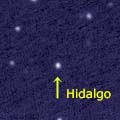
|
It reached to 13 mag and was observed visually in good condition in 2004 autumn. Then it has been fading on and on while being apart from the earth. It will be low in the evening sky at 16.5 mag in August.
Date(TT) R.A. (2000) Decl. Delta r Elong. m1 Best Time(A, h)
Mar. 26 3 42.24 60 33.7 2.167 2.050 69 15.3 19:27 (154,-17)
Apr. 2 4 13.70 61 1.5 2.223 2.072 68 15.3 19:17 (155,-16)
|
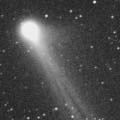
|
Fading gradually as predicted. It had been visible visually at 14 mag until January. But it became too faint to see visually after February. It will be 17 mag in June.
Date(TT) R.A. (2000) Decl. Delta r Elong. m1 Best Time(A, h)
Mar. 26 9 41.31 -8 33.3 3.983 4.791 140 15.3 21:24 (180, 64)
Apr. 2 9 36.01 -7 31.5 4.128 4.864 132 15.4 20:52 (180, 62)
|

|
Appearing at dawn and observed after a long time. Because there is a large difference among reported observations in 2004, the true brightness was uncertain. Actually, it was 16.0 mag (Feb. 11, Ken-ichi Kadota). It will be observable in good condition at 15 mag from April to June.
Date(TT) R.A. (2000) Decl. Delta r Elong. m1 Best Time(A, h)
Mar. 26 18 3.01 3 43.3 3.314 3.527 94 15.6 4:43 (205, 48)
Apr. 2 17 56.28 5 7.1 3.168 3.510 101 15.5 4:49 (190, 49)
|

|
New bright periodic comet discovered in 2004 spring. In last year, it had been bright at 15.0-15.5 mag from spring to summer. In this year, it is expected to be as bright as last year from spring to autumn. The ephemeris says it keeps brighter than 19 mag even around the aphelion, however, the comet had not been discovered before 2004. This suggests the comet became bright temporarily last year. But actually, it keeps the brightness for more than one year until now, 15.3 mag on Mar. 11.
Date(TT) R.A. (2000) Decl. Delta r Elong. m1 Best Time(A, h)
Mar. 26 19 38.50 -25 22.6 3.023 2.897 73 15.5 4:43 (266, 54)
Apr. 2 19 47.53 -25 33.5 2.938 2.903 78 15.5 4:49 (262, 59)
|

|
It brightened rapidly from 19 to 17 mag in early 2004. But it is in normal state now, 16.5 mag in early 2005. It keeps 15-16 mag for a long time until early 2007.
Date(TT) R.A. (2000) Decl. Delta r Elong. m1 Best Time(A, h)
Mar. 26 16 8.18 -19 0.4 2.670 3.304 121 15.7 3:55 (180, 74)
Apr. 2 16 8.38 -19 11.5 2.575 3.292 128 15.6 3:27 (180, 74)
|

|
Peculiar comet which becomes brightest about 5 months after the perihelion passage. It became brightest in February, about 5 months after the perihelion passage, as expected. However, it is fainter than expected in this return, and reaches to 15.5 mag at best. It was not visible visually, fainter than 14.0 mag (Feb. 5, Seiichi Yoshida).
Date(TT) R.A. (2000) Decl. Delta r Elong. m1 Best Time(A, h)
Mar. 26 10 4.55 33 28.8 2.154 2.920 132 15.7 21:48 (180, 22)
Apr. 2 10 3.38 33 14.8 2.236 2.937 125 15.9 21:19 (180, 22)
|
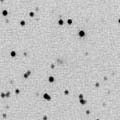
|
It came closer to the earth and reached to 15.5-16 mag by CCD observations. It looked diffused on the CCD images. So it was also visible visually at 14.3 mag (Feb. 6, Reinder J. Bouma). However, it will be getting apart from the earth after this, and getting fainter on and on.
Date(TT) R.A. (2000) Decl. Delta r Elong. m1 Best Time(A, h)
Mar. 26 8 25.91 41 14.2 1.361 1.962 111 16.1 20:10 (180, 14)
Apr. 2 8 36.56 38 23.7 1.420 1.975 108 16.2 19:54 (180, 17)
|
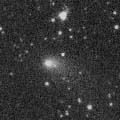
|
It had been fading rather faster than usual since the perihelion passage in 2004 spring. However, the fading turned to be slow after the end of 2004. It was already 15.4 mag on Dec. 16, then it kept almost constant brightness and 15.8 mag still on Mar. 6 (Akimasa Nakamura). It may be observable at 16 mag for a while after this.
Date(TT) R.A. (2000) Decl. Delta r Elong. m1 Best Time(A, h)
Mar. 26 9 58.75 39 57.5 3.596 4.271 126 16.4 21:42 (180, 15)
Apr. 2 9 54.23 39 1.7 3.737 4.338 121 17.5 21:10 (180, 16)
|

|
Recovery of a peculiar asteroid 2004 FS101 discovered in 2004 spring. Although it was 18 mag in mid January, it brightened to 16.7 mag in mid March. The brightness evolution was rather faster than that of a typical comet. It will be 14.5 mag around 2006 January, although it will be rather low for the northern observers. It keeps observable at 15-16 mag for a long time from 2005 spring to the end of 2006. Because it moves in the northern sky, it keeps observable for a long time in the Northern Hemisphere.
Date(TT) R.A. (2000) Decl. Delta r Elong. m1 Best Time(A, h)
Mar. 26 14 26.65 37 37.1 3.753 4.466 130 16.6 2:13 (180, 17)
Apr. 2 14 21.72 39 41.3 3.712 4.424 130 16.5 1:41 (180, 15)
|
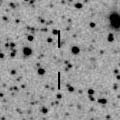
|
It will be low in the evening sky in May. It will be observable again in 2006 spring, but it will be fainter than now by 1 mag.
Date(TT) R.A. (2000) Decl. Delta r Elong. m1 Best Time(A, h)
Mar. 26 5 52.93 24 44.1 2.772 2.830 83 17.0 19:27 (153, 25)
Apr. 2 6 1.07 24 34.1 2.860 2.826 77 17.0 19:17 (150, 24)
|

|
Because it moves in the northern sky, it keeps observable for a long time in the Northern Hemisphere. The brightening in latter 2004 was rather faster than usual, however, it will reach to only 16 mag at best in early 2006.
Date(TT) R.A. (2000) Decl. Delta r Elong. m1 Best Time(A, h)
Mar. 26 5 4.50 48 15.0 5.706 5.550 75 17.2 19:27 (155, 0)
Apr. 2 5 9.37 48 18.4 5.778 5.526 70 17.2 19:17 (153, -2)
|
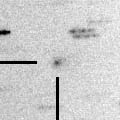
|
In its last return in 1997, it burst out after the perihelion passage and became extremely bright, reached to 11 mag. However, it is faint in this return. It has already passed the perihelion on Nov. 30, but it had been constant at 15.5 mag from November to January. Because this comet tends to brighten and fade very rapidly, it will fade out rapidly after March while being apart from the earth, and will be fainter than 18 mag in April. It has already faded to 17.5 mag in mid March.
Date(TT) R.A. (2000) Decl. Delta r Elong. m1 Best Time(A, h)
Mar. 26 8 55.71 38 13.7 1.506 2.163 118 17.4 20:40 (180, 17)
Apr. 2 9 1.47 37 49.8 1.596 2.188 112 17.7 20:18 (180, 17)
|

|
It was actually brighter than expected, 17.5-18 mag in March. It will keep 17.5 mag in the evening sky for a while until summer. But it will be getting lower and lower after June.
Date(TT) R.A. (2000) Decl. Delta r Elong. m1 Best Time(A, h)
Mar. 26 11 31.20 -0 59.7 1.414 2.398 167 17.7 23:14 (180, 56)
Apr. 2 11 26.85 0 5.4 1.410 2.373 159 17.6 22:42 (180, 55)
|

|
Split comets. It will be fainter than 18 mag soon. The component B is fainter than A by 0.6 mag.
Date(TT) R.A. (2000) Decl. Delta r Elong. m1 Best Time(A, h)
Mar. 26 9 6.76 40 0.1 3.841 4.413 119 17.7 20:50 (180, 15)
Apr. 2 9 6.56 39 28.5 3.926 4.414 113 17.7 20:23 (180, 16)
|
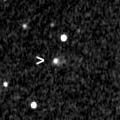
|
It kept 16.5 mag in December and January. But it will fade out after that, and will be fainter than 18 mag in April.
Date(TT) R.A. (2000) Decl. Delta r Elong. m1 Best Time(A, h)
Mar. 26 10 11.53 33 30.6 2.131 2.908 133 17.8 21:55 (180, 22)
Apr. 2 10 9.14 33 7.2 2.236 2.948 127 17.9 21:25 (180, 22)
|
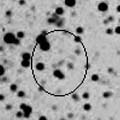
|
Because it is a far object, it has been observed at 17.5 mag for one and a half year since 2003 summer. It has already passed the perihelion, so it will become a bit fainter this year. But it keeps 18 mag until summer.
Date(TT) R.A. (2000) Decl. Delta r Elong. m1 Best Time(A, h)
Mar. 26 16 25.01 41 23.1 6.876 7.271 109 17.8 4:11 (180, 14)
Apr. 2 16 19.52 42 9.3 6.846 7.286 112 17.8 3:38 (180, 13)
|
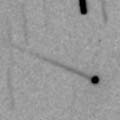
|
Fading slowly along with a magnitude formula as an asteroid of H=13.7 mag. It keeps observable in good condition until April when it becomes fainter than 18 mag. Almost stellar, so it must be easy to detect even if so faint.
Date(TT) R.A. (2000) Decl. Delta r Elong. m1 Best Time(A, h)
Mar. 26 5 9.23 51 31.1 1.885 1.931 77 17.8 19:27 (157, -3)
Apr. 2 5 33.48 51 1.8 1.990 1.983 75 18.0 19:17 (158, -2)
|

|
Because it is a far object, it has been observed almost 4 years since 2001 summer. It had been observed at 17 mag for more than 1 year from 2003 summer to 2004 summer. It has already passed the perihelion, and it became a bit fainter in early 2005 as 17.7 mag. It will be faintr than 18 mag in spring.
Date(TT) R.A. (2000) Decl. Delta r Elong. m1 Best Time(A, h)
Mar. 26 13 5.30 53 39.8 6.336 6.935 123 17.9 0:53 (180, 1)
Apr. 2 12 55.07 53 52.3 6.391 6.962 121 18.0 0:15 (180, 1)
|
|
![]()
 78P/Gehrels 2
78P/Gehrels 2 141P/Machholz 2
141P/Machholz 2 C/2004 Q1 ( Tucker )
C/2004 Q1 ( Tucker ) 49P/Arend-Rigaux
49P/Arend-Rigaux 161P/2004 V2 ( Hartley-IRAS )
161P/2004 V2 ( Hartley-IRAS ) 29P/Schwassmann-Wachmann 1
29P/Schwassmann-Wachmann 1 62P/Tsuchinshan 1
62P/Tsuchinshan 1 C/2004 L1 ( LINEAR )
C/2004 L1 ( LINEAR ) C/2001 Q4 ( NEAT )
C/2001 Q4 ( NEAT ) C/2004 B1 ( LINEAR )
C/2004 B1 ( LINEAR ) C/2003 WT42 ( LINEAR )
C/2003 WT42 ( LINEAR ) 37P/Forbes
37P/Forbes (944) Hidalgo
(944) Hidalgo C/2002 T7 ( LINEAR )
C/2002 T7 ( LINEAR ) C/2004 K1 ( Catalina )
C/2004 K1 ( Catalina ) P/2004 F3 ( NEAT )
P/2004 F3 ( NEAT ) 117P/Helin-Roman-Alu 1
117P/Helin-Roman-Alu 1 121P/Shoemaker-Holt 2
121P/Shoemaker-Holt 2 C/2004 RG113 ( LINEAR )
C/2004 RG113 ( LINEAR ) C/2003 T3 ( Tabur )
C/2003 T3 ( Tabur ) C/2005 B1 ( Christensen )
C/2005 B1 ( Christensen ) 129P/Shoemaker-Levy 3
129P/Shoemaker-Levy 3 C/2004 D1 ( NEAT )
C/2004 D1 ( NEAT ) 69P/Taylor
69P/Taylor 105P/Singer Brewster
105P/Singer Brewster P/2004 V5 ( LINEAR-Hill )
P/2004 V5 ( LINEAR-Hill ) 164P/2004 Y1 ( Christensen )
164P/2004 Y1 ( Christensen ) C/2003 O1 ( LINEAR )
C/2003 O1 ( LINEAR ) 162P/2004 TU12 ( Siding Spring )
162P/2004 TU12 ( Siding Spring ) C/2002 J5 ( LINEAR )
C/2002 J5 ( LINEAR )![]()
























